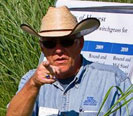
by Marvin Hall
Extension Forage Agronomist
Penn State University
Dry weather during much of August and September has been great for harvesting perennial forages and corn silage. Corn silage harvest is nearly complete, but hay and haylage harvest continues as farmers are seizing every opportunity to make quality hay after a rainy summer left many farmers short of high-quality forages. Late-summer forage seeding is nearly complete, and cover crop forage seeding is in full swing.

Forage Extension Specialist
Montana State University
A lot of producers in the central and western parts of the state are taking their last hay harvests under irrigation. Hay has started to move, and according to weekly numbers posted, prices are fairly good and have increased over recent weeks. Montana hay prices, on average, have been reported as higher than surrounding states. Rainfall in some parts of the state prevented producers from taking a timely harvest, with a lot putting up more mature hay than planned.
There is quite a bit of forage demand in many parts of Montana, particularly for small-acreage owners and those in areas that were hard-hit by drought. Hay exports have started to move, mainly at the bottom end of the quality range.
There are also several reports of heavy gopher infestations that are preventing final hay harvests in the northwestern part of the state. Gopher damage has prevented farmers from being able to get into the fields, with what appears to be a resurging gopher population.


Extension Forage Specialist
Many areas of Kentucky have had negligible rain for the past six weeks. This is quite the contrast from May through July when rainfall was in excess. The dry weather has been great for making hay, but yields on grass and predominately grass hayfields have suffered. Many producers do not expect a fall grass hay harvest and some have even seen lower than expected fall alfalfa yields. USDA Ag Statistics (Sept 21) rates 45 percent of Kentucky pastures in the poor to fair range with topsoil moisture ratings as follows: 11 percent very short, 37 percent short, 49 percent adequate and 3 percent surplus. Some livestock producers have already started feeding hay. Corn silage production is average to above average for most producers.
With few exceptions, forage establishment conditions are poor. Many producers have decided to wait for rainfall before seeding, but the recommended window for successful fall establishment has passed or is rapidly closing (alfalfa-Sept. 15, orchardgrass-Sept. 20, tall fescue-Oct. 1).
There have been no significant forage insect outbreaks, including fall armyworm, which has been an issue in some areas in past years. Kentucky livestock producers are definitely encouraged to test hay before purchasing or feeding this winter with low quality expected from early season harvests and excellent quality from late harvests.

